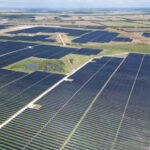By now many of us may have heard of solar power or wind power or even both and how they are changing the face of our energy future. But how about sea waves? How can the sea’s waves be used to generate energy without impacting aquatic life? That’s the question an Israeli company hopes to answer practically as it build one of such plants on the coastline of Accra; the capital of Ghana.
Called Yam Pro Energy, says it can carry this out by utilising the crashing waves to produce hydraulic pressure thereby turning this into electricity. Speaking to CNN, Yam Pro Energy’s CEO, Zeev Peretz said “We negotiated (with Ghana) for many years, but in the end we succeeded.The demand (for energy) is very big and I think it will help people (improve) their life. Floaters will be connected to wave breakers on the coastline and will bob up and down as waves crash in.”
With respect to the environment Peretz said their machines do not emit pollution but the other side to this very clean energy source is that setting it up is quite expensive. That said, the company says running costs including maintenance are low once initial set up is completed.
The technology behind the concept is straightforward and unlike other sources of energy like solar and wind, sea waves are quite predictable and even reliable because regardless of weather conditions, the sea generates waves which sea animals sometimes depend on. Put simply, it’s quite difficult not to see the sea generating waves and this is the first step to the eventual success of the project.
Peretz also told CNN that “their technology was much more efficient than other renewable energy sources because it can generate 65% of energy per year, compared to solar panels and wind turbines which generate between 22-24%.”
But International Renewable Energy Agency (IRENA) thinks the biggest challenge with wave power is proving it can withstand the sea’s harsh environments.
“There are quite a lot of prototypes and they’re doing quite well, but (for an investor), the main point is over 20 years — how will the machine perform?” Other environmental activists say there is no power project that has zero emission so we shouldn’t just conclude that generating power from waves would be 100 percent clean and so a proper environmental impact assessment ought to be carried out.
Like other renewable sources of energy, this one could serve as a complement and right now, it’s hard to see how it would overtake other sources seeing as it is expensive to set up. This means, households would bear the cost eventually. The country of Ghana aims to power its households with clean energy y 2050 and wave power could account for 1.4 percent of that.
The Ghana project is due to commence in 2017 and will benefit 10,000 households on completion. The company has secure a power purchase agreement with local authorities which will allow it sell electricity through the national grid as well.
Ghana and Nigeria are the two biggest economies in the West African sub region and while Ghana has a population of about 26 million people, Nigeria has a population of 180 million people. Ghana has a total installed power capacity of 3,644MW while Nigeria has an installed capacity of 10,300MW while the highest it has sent to the population is 6,056MW. Currently the figure is about 3,500MW and it is estimated that Nigeria needs about 160,000MW to meet daily national demands. This comes as there is a recession which has made it difficult for the government to invest further in power projects. This is why a different approach is needed and right now, all electric power is needed to bridge this huge shortfall.
Discover more from TechBooky
Subscribe to get the latest posts sent to your email.







